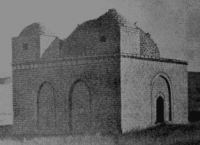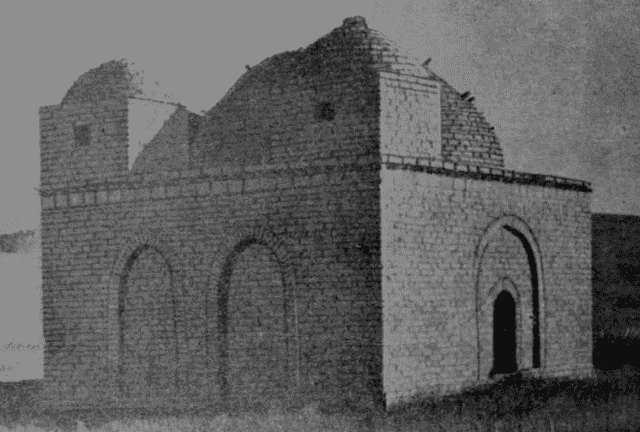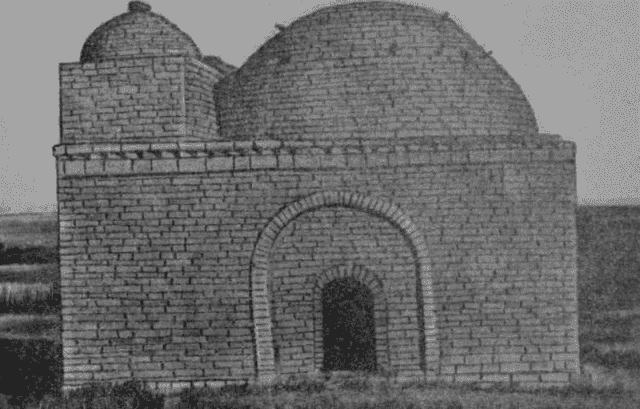Вы здесь
Dyusembek Mausoleum.

Destinations and routes in Ulytau.
"Great buildings, like high mountains - creations of the ages"
Victor Hugo.
Great Silk Road of Ulytau.
Dyusembek Mausoleum is located at an altitude of 377 meters above sea level, located in eastern part of ancient Daumbai cemetery, on left bank of drying up Zhylynda riverbed, 9.7 kilometers from right (western) bank of Kara-Kengir River, 16 kilometers to west and slightly north from village of Karganbay, 16.3 kilometers to north and slightly east of town of Satpayev in Ulytau district of region of same name.
“In the vicinity of the Burabay mausoleum, there is the Dyusembek mausoleum, which dates back to the 90s of the 19th century and is quite well preserved. In its external forms, it differs from other similar structures.
In terms of volumetric composition, Dyusembek belongs to centric structures. Its base - a parallelepiped - is crowned with a dome, and in the corners, on the front wall facing south-west, there are two towers in the form of small cubes, topped with small domes.
When assembling the main facade of this monument, the builders abandoned the construction of the traditional portal or its primitive, which had been practiced for centuries in the construction of religious buildings.
At the first glance, it becomes clear that its architectural forms to a certain extent reflect the techniques and traditions of Russian stone architecture, which gradually penetrated into Kazakhstan from the second half of the XIXth century.
The use of an unusual composition of two-part division, the presence of bow-shaped and semicircular arches along with lancet arches speak of the eclecticity of the architectural forms of this structure. In terms of the outer outline, the mausoleum is a rectangle with sides measuring 6.76 x 6.00 meters, and inside - 4.60 x 4.55 meters, that is, almost a square.
The lengthening of the sides was due to the thickening of the front (southwestern) wall, reaching up to 130 cm, in the masonry mass of which a gallery was arranged connecting ladders-manholes leading up to the dome.
The smooth surface of the front façade wall is enlivened by two peshtaks 18 cm deep, the floors of which are decorated with pointed arches. There is a similar niche 9 cm deep on the southeastern wall with a semicircular arch. In the middle of this niche, an entrance opening measuring 0.75 x 1.24 meters is made, which is also completed with a semicircular arch.
In contrast to traditional rules, the entrance to the mausoleum is made here not on the main facade, but on the side, facing southeast. This departure from well-established rules is difficult to explain. But this, apparently, was caused by necessity, since, on the main facade, which has two adjacent niches, it was impossible to make a doorway along the axis of the building.
In addition, this opening could interfere with the gallery device at the level of the second floor, so the passage was moved to the side. Perhaps this is due to the fact that the old strict requirements for the entrance device on the main facade were necessarily violated by some free methods that penetrated the construction practice of the later period.
Inside, in the corners of the mausoleum, there are small cross-over arches on protruding heels, which make it possible to move from a square plan to an octagonal one. Then the octahedron, with the help of a cellular masonry in its corners, goes to the circle of the dome drum.
The corners of the sails under the arches are also decorated with a cellular masonry with four tiers of stalactites. To the left of the entrance in the thickness of the front wall for access to the platform around the dome, as indicated above, there are two manholes, each 0.54 x 1.39 meters in size.
Due to the large limited size, it is very difficult to use these manholes. They are connected by a gallery measuring 50 x 1.30 meters. The right passage-manhole does not have an exit to the upper platform to the dome, you can get to the dome only through the left turret, in the floor of which there is a special hole-hole 0.50 x 0.55 meters in size, there is a hole of about the same size in the rear wall towers for access to the site - to the dome.
The towers are small in size - 1.92 x 1.63 meters and 1.10 meters high. Their purpose is unknown. Most likely, they were set only as an architectural design in imitation of Russian building art. To illuminate their chambers, small holes of 20 x 25 cm were left in the brickwork on the front facades.
The dome above the chamber of the mausoleum was externally brought out in the same way as in the Burbay mausoleum, without being installed on a traditional multifaceted drum. Such examples in the practice of building the mausoleum are later encountered quite often.
They are the result of striving for simplified techniques in the folk art of building. The dome is folded rather carefully in radial rows, in the form of wedge-shaped masonry, which ensured its preservation. But, despite this, the builders were unable to maintain a spherical shape, so the dome turned out to be a little conical. In the direction of the main axes of the structure in the dome, according to tradition, four small holes are left through which insignificant light enters.
For the same reason, the ends of small perches 30 x 40 cm long and 2 - 3 cm thick were inserted into the masonry of the outer surface of the dome in a checkerboard pattern. The building was erected entirely of scarlet baked bricks on clay mortar.
The quality of the brick is good. The inner surfaces of the walls and the dome are plastered with clay and adobe mortar and whitewashed with lime. There is a shallow foundation 25-30 cm under the building, and above it there is a plinth of the same height.
Built of limestone (sandstone, marl and other types of stones) on clay mortar, they reliably ensured the safety of the structure. The floor inside the building was placed below the outside ground level and lined with bricks in a single row “flat”.
Two sagans were erected on it, the larger one was placed over the grave of Dyusembek himself, and the smaller one over the grave of his wife, which indicated the dominant position of the husband in the family. Currently, this monument is in a satisfactory condition.
With proper supervision, the Dyusembek mausoleum can be preserved for a long time.
Geographic coordinates of the Dyusembek Mausoleum: N48°03'01 E67°34'50


Authority and photos:
G.G. Gerasimov. "Architectural monuments of the valley of the Kara-Kengir river in Central Kazakhstan". Publishing house of the Academy of Sciences of the Kazakh SSR. Alma-Ata. 1957.







